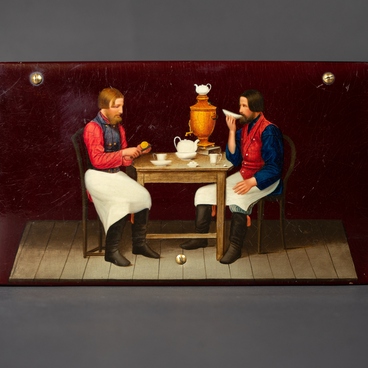Tobacco gained enormous popularity in the 17th-18th centuries, and later Europeans developed a passion for smoking. Thus, special cases and boxes for storing tobacco products appeared. At first, snuffboxes, cigarette cases, cigarette holders and cigar holders were an important attribute of the court culture, and later of material culture of nobility. Over time, they became objects of general admiration.
They remained fashionable throughout the 19th century: snuffboxes and cigarette cases were not only convenient for everyday use, but also served as valuable gifts. People often amassed vast collections of these items.
The cigarette case with a female portrait was made at the famous Lukutin Factory which was located near Moscow in the 1840s. The miniatures, painted on the sides of the case, — a portrait of a young woman with a book and an image of a parrot on the reverse side — indicate that this case belonged to a woman. Most likely, the portrait was copied from a painting or a print by Russian or Western European artists.
On the first miniature, the master depicted an idealized image of female beauty. It is romantic and a little sentimental. The artist conveyed the most prominent features of this era: the countenance of the girl’s pretty face, the softness of the contours and shades, her feminine figure, the mandatory set of accessories (flowers and a book), the light dress and cape trimmed with ermine in the very latest fashion — all this corresponded to the aesthetic ideals of the 19th century.
The master-miniaturist complimented the elegant shape of the cigarette case with a delicate gold-leaf pattern. Gold leaf is a real metal, hammered into the thinnest sheets with a thickness of only a fraction of a micron. Due to this treatment (goldbeating), it adheres to any smooth surface, so it is often used for gilding sculptures and jewelry, as well as in icon painting and lacquer miniatures.
The artist created a pattern with decorative foliage scrollwork in the Rococo style. Rococo is a style that originated in France in the 18th century during the reign of Louis XV. It corresponded to the tastes of the court nobility of that era and was distinguished by the elegance of lines, ponderous and whimsical patterns.
They remained fashionable throughout the 19th century: snuffboxes and cigarette cases were not only convenient for everyday use, but also served as valuable gifts. People often amassed vast collections of these items.
The cigarette case with a female portrait was made at the famous Lukutin Factory which was located near Moscow in the 1840s. The miniatures, painted on the sides of the case, — a portrait of a young woman with a book and an image of a parrot on the reverse side — indicate that this case belonged to a woman. Most likely, the portrait was copied from a painting or a print by Russian or Western European artists.
On the first miniature, the master depicted an idealized image of female beauty. It is romantic and a little sentimental. The artist conveyed the most prominent features of this era: the countenance of the girl’s pretty face, the softness of the contours and shades, her feminine figure, the mandatory set of accessories (flowers and a book), the light dress and cape trimmed with ermine in the very latest fashion — all this corresponded to the aesthetic ideals of the 19th century.
The master-miniaturist complimented the elegant shape of the cigarette case with a delicate gold-leaf pattern. Gold leaf is a real metal, hammered into the thinnest sheets with a thickness of only a fraction of a micron. Due to this treatment (goldbeating), it adheres to any smooth surface, so it is often used for gilding sculptures and jewelry, as well as in icon painting and lacquer miniatures.
The artist created a pattern with decorative foliage scrollwork in the Rococo style. Rococo is a style that originated in France in the 18th century during the reign of Louis XV. It corresponded to the tastes of the court nobility of that era and was distinguished by the elegance of lines, ponderous and whimsical patterns.



